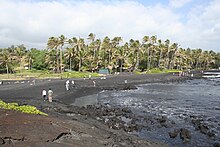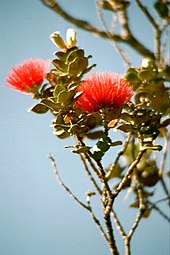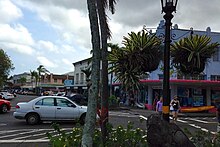SCUBA Diving in Hawaii~ "The Big Island"
Hawaiʻi (/həˈwaɪ.i/ or /həˈwɑːiː/; Hawaiian: [həˈvɐjʔi]), is the largest island located in the U.S. state of Hawaii.
It is the largest and the southeastern-most of the Hawaiian islands, a chain of volcanic islands in the North Pacific Ocean.
With an area of 4,028 square miles (10,430 km2), it is larger than all of the other islands in the archipelago combined and is the largest island in the United States.
The island of Hawaii is the third largest island in Polynesia, behind the two main islands of New Zealand.
The island is often referred to as the Island of Hawaiʻi,[2] the Big Island, or Hawaiʻi Island to distinguish between the island and the state.
It is coterminous with Hawaiʻi County and includes the Hilo Micropolitan Statistical Area.
As of the 2010 Census the population was 185,079.[3]
The county seat and largest city is Hilo.
There are no incorporated cities in Hawaiʻi County (see Hawaii Counties).

Landsat mosaic, 1999–2001.
|
|
 |
|
| Geography | |
|---|---|
| Location | 19°34′N 155°30′W |
| Archipelago | Hawaiian Islands |
| Area | 4,028 sq mi (10,430 km2) |
| Area rank | 1st, largest island in the United States |
| Highest elevation | 13,803 ft (4,207.2 m) |
| Highest point | Mauna Kea |
| Country | |
United States
|
|
| State | Hawaii |
| Symbols | |
| Flower | Red Pua Lehua ('Ohi'a blossom)[1] |
| Color | ʻUlaʻula (red) |
| Demographics | |
| Population | 185,079 (as of 2010) |
| Density | 46 /sq mi (17.8 /km2) |
History
Main article: History of Hawaii
James Kealoha Beach, "4-Mile Beach," in Hilo
Other accounts attribute the name to the legendary realm of Hawaiki, a place from which the Polynesian people are said to have originated (see also Manua), the place where they go in the afterlife, the realm of the gods and goddesses.
The name is cognate with Savaii, the name of the largest island of Samoa.[citation needed]
Captain James Cook, the English explorer and navigator who was the captain of the first European expedition that discovered the Hawaiian Islands, called them the "Sandwich Islands" after his patron, the Earl of Sandwich.[4]
Cook was killed on the Big Island at Kealakekua Bay on February 14, 1779, in a mêlée which followed the theft of a ship's boat.[5]
Hawaiʻi was the home island of Paiʻea Kamehameha, later known as Kamehameha the Great.
Kamehameha united most of the Hawaiian islands under his rule in 1795, after several years of war, and gave the kingdom and the island chain the name of his native island.
Geology and geography
Aerial view, 3D computer-generated image
The county's land area comprises 62.7 percent of the state's land area. It is the highest percentage by any county in the United States. (Delaware's Sussex County comes in second at 48.0 percent, while Rhode Island's Providence County is third at 39.55 percent.)
In greatest dimension, the island is 93 miles (150 km) across and has a land area of 4,028 square miles (10,430 km2)[7] comprising 62% of the Hawaiian Islands' land area.
Measured from its sea floor base to its highest peak, Mauna Kea is the world's tallest mountain, taller than Mount Everest is, since the base of Mount Everest is above sea level.[8]
A view of the Kohala Coast and adjacent volcanoes, from left to right,
Mauna Kea, Mauna Loa,
and Hualalai, taken from the slopes of Kohala
Mountains about six miles northwest of Kawaihae.
Volcanism
The five shield volcanoes
Steam plume as Kīlauea red lava enters the ocean at three Waikupanaha
and one Ki lava ocean entries. Some surface lava is seen too. The image
was taken on April 16, 2008.
Geologists now consider these "outcrops" to be part of the earlier building of Mauna Loa.
Another volcano which has already disappeared below the surface of the ocean is Māhukona.
Because Mauna Loa and Kīlauea are active volcanoes, the island of Hawaii is still growing.
Between January 1983 and September 2002, lava flows added 543 acres (220 ha) to the island.
Lava flowing from Kīlauea has destroyed several towns, including Kapoho in 1960, and Kalapana and Kaimu in 1990.
In 1987 lava filled in Queen's Bath, a large, L-shaped, freshwater pool in the Kalapana area.
The southmost point in the 50 States of the United States, Ka Lae, is on Hawaii. The nearest landfall to the south is in the Line Islands.
To the north of the Island of Hawaii is the Island of Maui, whose Haleakala volcano is visible from Hawaii across the Alenuihaha Channel.
Approximately 35 km (22 mi) southeast of Hawaii lies the undersea volcano known as Loihi. Loihi is an erupting seamount that now reaches approximately 3,200 feet (980 m) below the surface of the ocean.
Continued activity at current rates from Loihi will likely cause it to break the surface of the ocean sometime from 10,000 to 100,000 years from now.
The Great Crack
Lava entering the Pacific at Hawaii Volcanoes National Park in April 2005, increasing the size of the island.
The visitor can find trails, rock walls, and archaeological sites from as old as the 12th century around the Great Crack.
Approximately 1,951 acres (7.90 km2) of private land were purchased during the Presidency of Bill Clinton, specifically to protect various artifacts in this area as well as the habitat of local wildlife.
The Hilina Slump
Main article: Hilina Slump
Punalu'u Black Sand Beach Park
Between 1990 and 1993, Global Positioning System (GPS) measurements showed a southward displacement of about 3.9 inches (10 cm) per year.[11]
Undersea measurements show that a "bench" has formed a buttress and that this buttress may tend to reduce the likelihood of future catastrophic detachment.[12][13]
Earthquakes and tsunamis
Big Island Beach
Anaeho'omalu Beach Panorama
This was the most destructive earthquake in the recorded history of Hawaii.[14]
It triggered a landslide on Mauna Loa, five miles (8.0 km) north of Pahala, killing 31 people.
A tsunami claimed 46 more lives.
The villages of Punaluu, Ninole, Kawaa, Honuapo, and Keauhou Landing were severely damaged.
The tsunami reportedly rolled over the tops of the coconut trees up to 60 feet (18 m) high, and it reached inland a distance of a quarter of a mile (0.4 km) in some places.[15]
On November 29, 1975, a 37-mile-wide (60 km) section of the Hilina Slump dropped 11.5 feet (3.5 m) and slid 26 feet (7.9 m) toward the ocean.
This movement caused a 7.2 magnitude earthquake and a 48-foot-high (15 m) tsunami. Oceanfront property was washed off its foundations in Punaluu. Two deaths were reported at Halape, and 19 other people were injured.
The island suffered tsunami damage from earthquakes in Alaska on April 1, 1946, and in Chile on May 23, 1960.
Downtown Hilo was severely damaged by both tsunamis, with many lives lost. Just north of Hilo, Laupahoehoe lost 16 schoolchildren and five teachers in the tsunami of 1946.
In March 2011, a 9.0 magnitude earthquake off the east coast of Japan again created a tsunami that caused minor damage in Hawaii.
The estimated damage to public buildings alone was about $3 million.[16]
In the Kona area this tsunami washed a house into Kealakekua Bay, destroyed a yacht club and tour boat offices in Keauhou Bay, caused extensive damage in Kailua Kona, flooded the ground floor of the King Kamehameha Hotel,[17] and permanently closed the Kona Village Resort.
Volcanic fog
Vog (volcanic fog) can envelop the island.The gas plumes of the Kīlauea Volcano create a blanket of vog which the dominant trade winds mostly deflect toward the Kona coast on the west side of the Island of Hawaiʻi.
Vog contains chemicals that can damage the environment, and the health of plants, humans and other animals.
Most of the aerosols are acidic and of a size where they can remain in the lungs to damage the lungs and impair function.
Flu-like symptoms and general lethargy are reported, especially pronounced in people with respiratory conditions.[18][19][20][21]
National protected areas
Lehua blossoms, Hawaiʻi
- Ala Kahakai National Historic Trail
- Hakalau Forest National Wildlife Refuge
- Hawaiʻi Volcanoes National Park
- Honokōhau Settlement and Kaloko-Honokōhau National Historical Park
- Kona Forest National Wildlife Refuge
- Puʻuhonua o Hōnaunau National Historical Park
- Puʻukoholā Heiau National Historic Site
Adjacent counties
- Maui County - northwest
Demographics
| Historical population | |||
|---|---|---|---|
| Census | Pop. | %± | |
| 1900 | 46,843 | — | |
| 1910 | 55,382 | 18.2% | |
| 1920 | 64,895 | 17.2% | |
| 1930 | 73,325 | 13.0% | |
| 1940 | 73,276 | −0.1% | |
| 1950 | 68,350 | −6.7% | |
| 1960 | 61,332 | −10.3% | |
| 1970 | 63,468 | 3.5% | |
| 1980 | 92,053 | 45.0% | |
| 1990 | 120,317 | 30.7% | |
| 2000 | 148,677 | 23.6% | |
| 2010 | 185,079 | 24.5% | |
| Est. 2013 | 190,821 | 3.1% | |
There were 64,382 households in the county.
The population density was 17.7/km² (45.9/mi²).
There were 82,324 housing units at an average density of 8/km² (20/mi²).
The racial makeup of the county was 34.5% White, 0.7% African American, 22.6% Asian, 12.4% Native Hawaiian or other Pacific Islander, and 29.2% from two or more races; 11.8% of the population were Hispanics or Latinos of any race.
There were 64,382 households out of which 32.20% had children under the age of 18 living with them, 50.60% were married couples living together, 13.20% had a woman whose husband did not live with her, and 30.40% were non-families.
23.10% of all households were made up of individuals and 8.00% had someone living alone who was 65 years of age or older.
The average household size was 2.75 and the average family size was 3.24.
The age distribution was 26.10% under 18, 8.20% from 18 to 24, 26.20% from 25 to 44, 26.00% from 45 to 64, and 13.50% who were 65 or older.
The median age was 39 years.
For every 100 females there were 100 males. For every 100 females age 18 and over, there were 98 males.
Downtown Kona, Hawaii
Downtown Hilo, Hawaii
Government and infrastructure
Source: Wikipedia.org
Somebody Come and Play In the Traffic With Me! Earn as You Learn, Grow as You Go!
The Man Inside the Man
from
Sinbad the Sailor Man
A
JMK's Production
Share this page, If you liked It Pass it on, If you loved It Follow Me!
TTFN
CYA Later Taters!
Thanks for watching.
Donnie/ Sinbad the Sailor Man
Somebody Come and Play in "Traffic" with me. If you would like to "Join" A Growing Biz Op! Here is Your Chance to get in an Earn While You Learn to Do "The Thing" with us all here at Traffic Authority.
Simply click this link and Grow as you Go Come and Play In Traffic With Me and My Team at Traffic Authority!
Simply click this link and Grow as you Go Come and Play In Traffic With Me and My Team at Traffic Authority!
P.S. Everybody Needs Traffic! Get Top Tier North American Traffic Here!















No comments:
Post a Comment